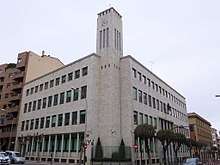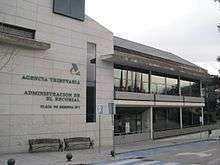Spanish Tax Agency
| Agencia Estatal de Administración Tributaria | |
 | |
| Agency overview | |
|---|---|
| Formed | January 1, 1992 |
| Jurisdiction | Spain |
| Headquarters |
Madrid, |
| Employees | 25.429 (2015) |
| Annual budget | €1.382 billion (2015)[1] |
| Agency executives |
|
| Parent agency | Ministry of the Treasury and Public Function |
| Child agency | |
| Website |
www |
The Agencia Estatal de Administración Tributaria (AEAT), commonly known as Agencia Tributaria is the revenue service of the Kingdom of Spain. The agency is responsible for the effective application of the national tax and customs systems, and for those resources belonging to other State Public Administrations and the European Union which are entrusted to it for management by law or agreement.[3]
For the investigation, prosecution and repression of contraband and other crimes related to organized crime, drug trafficking or money laundering counts on an armed police body, the Customs Surveillance Service.
History
The Tax Agency was created officially in 1991, by the Act 31/1990 of December 27th but it wasn't constituted effectively until January 1, 1992. It was set up as a public law organisation attached to the former Ministry of Economy and Treasury through the former State Secretariat for Finance and Budget. As such organisation of public law, it has its own legal regulation different from that of the General Administration of the State, a regulation which, without detriment to the essential principles that must preside over every administrative performance, confers a certain autonomy to it in budgetary and personnel management issues.
.jpg)

Functions and mission
It is therefore the Tax Agency's duty to apply the tax system in such a way that the constitutional principle is complied with by virtue of which everyone has to contribute to the maintenance of public expenditure according to his or her economic capacity. Yet, it does not have the competencies for the elaboration and approval of tributary norms nor can it assign, in the aspect of public expenditure, the public resources among the different aims. The function of integral management of the state and customs tax system materialises in a wide ensemble of activities, among which there are the following:
- The management, inspection and collection of the taxes that belong to the state (Personal Income Tax, Corporation Income Tax, Income Tax for Non-Residents, Value Added Tax and Special Taxes).
- The performance of important functions in relation to the income of the Autonomous Communities and Autonomous Cities, not only concerning the management of the Income Tax, but also the collection of other income from these Communities, whether by legal regulation or by the relevant collaboration agreements.
- The collection of revenue on behalf of the European Union.
- The management of customs and the repression of smuggling.
- The collection of taxes due to the State Public Sector in the voluntary payment period.
- The collection, through enforcement, of public revenue due to the State General Administration and associated or dependent Public Bodies.
- Participation in the persecution of certain offences, including offences against the Public Treasury and offences related to contraband goods.
Likewise, other autonomous and local organs manage own taxes and transferred taxes.
The mission of the Tax Agency is to encourage all citizens to discharge their tax duties. It performs two lines of action to achieve this: on the one hand, the provision of information and assistance services for taxpayers in order to minimise the indirect costs associated with meeting tax obligations and, on the other, through the detection and correction of tax defaults through control actions.[3]
Government of the agency
The President of the AEAT has the rank of Secretary of State and is also the Secretary of State of the Treasure, which is a person designated by the Government for this purpose at the proposal of the Minister of the Treasury and Public Function.
The General Director of the AEAT has the rank of Under Secretary of State and is also designated by the Government.
Structure
- President of the AEAT
- Superior Council for the Management and Coordination of Tax Management
- Standing Steering Committee
- Coordination Committee of the Territorial Directorate
- Committee on Safety and Security
- General Director of the AEAT
- Cabinet
- Internal Audit Service
- Delegated Intervention
- Unit of Support to the Special Prosecutor (economic crimes)
- Department of Tax Management

- Department of Financial and Tax Inspection
- Department of Collections
- Department of Customs and Special Taxes
- HR department
- Department of Tax Information
- Legal Service
- Economic Management Service
- Taxation and Statistics Service
- Planning and Institutional Relations Service
- Central Delegation of Great Contributors
- Special Delegations[4]
The agency is organized in 17 special delegations, one for each autonomous community. Of these, it depends 39 smallest delegations and another 31 special delegations for customs and special taxes. With competencies throughout the national territory, there is the Central Delegation of Large Taxpayers (which are persons or companies which contribute a lot or with some specials taxes).
See also
Similars revenue services:
- Internal Revenue Service, United States of America.
- HM Revenue and Customs, United Kingdom.
- Administración Federal de Ingresos Públicos, Argentina.
- Australian Taxation Office, Australia.
- Secretaria da Receita Federal do Brasil, Brasil.